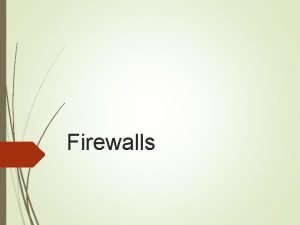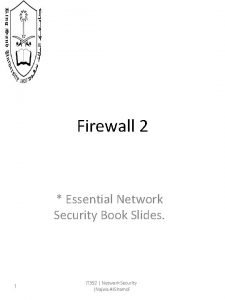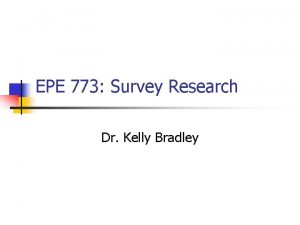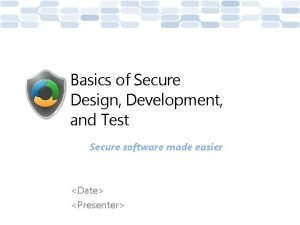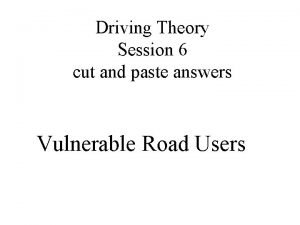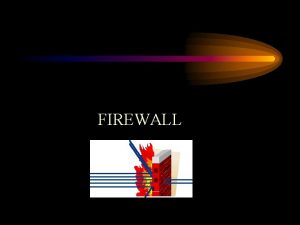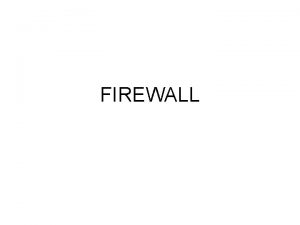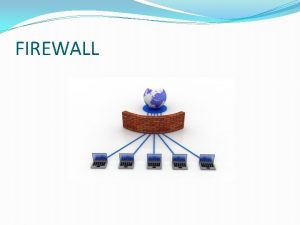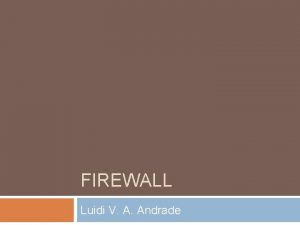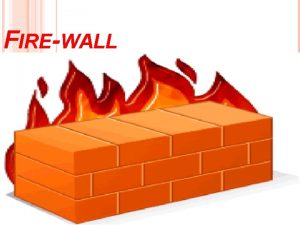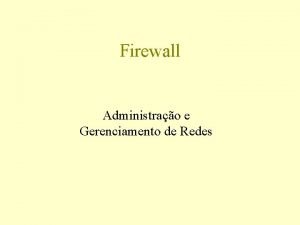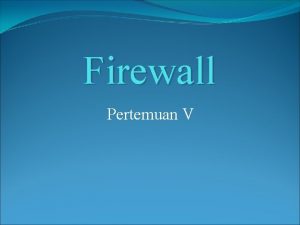Firewall Survey Purpose of a Firewall To allow













- Slides: 13

Firewall – Survey • Purpose of a Firewall – To allow ‘proper’ traffic and discard all other traffic • Characteristic of a firewall – All traffic must go through the firewall – Allow and blocking traffic – The Firewall itself should be immune of attacked

Firewall – possibilities • 5(6) areas to control: – Services (web, ftp, mail …) i. e. Port# – Network (hosts) i. e. IP addresses – Direction i. e. control inside-out or reverse – User i. e. only authorized users allow – Behaviour (e. g. attachment to mail) – (Denial of Service Inspection)

Firewall – solutions • Solutions: – HW – screening router – SW – Computer Based (build in the OS) – SW – dedicated Host Firewall

Firewall – limitations • 3 limitations of Firewalls – Cannot protect against traffic not running trough the firewall (obvious!!) – Cannot protect against threats from inside (e. g. as the school network) – Cannot protect against viruses (i. e. they come in by legal traffic)

Firewall – Types • 3 types of Firewalls – Packet-filtering – with state-full inspection – Application- gateways

Firewall – Packet-filtering • Level 3 – network (IP-packets) – Filtering on (the access control list): • • • Source/Destination IP-addresses Source/Destination Port-numbers IP-protocol field (e. g. icmp, tcp, egp) TCP-direction (SYN-bit) IN / OUT on each interface ICMP message type

Firewall – Packet-filtering • Configurations – Policies: 1: optimistic: default set to allow 2: pessimistic: default set to discard (normal) – Setting up rules

Firewall – Packet-filtering • Weakness – Cannot ‘look’ into appl. Level information – Limited logging information – Do normally not support authentication – Can be attack by weakness in IP (e. g. IP-spoofing)

Firewall – Packet-filtering • Stateful - inspection – Normal packet-filtering only look at one packet at a time. – Stateful packet-filtering can remember a sequence of packets. (can be used to detect spoofing)

Firewall – Application-level • Level 5 Application gateway – Using Proxy Servers (e. g. a mail-client and a mail-server) • Spilt connections into 2 (one for inbound and one for outbound)

Firewall – Application-level • More secure – Stateful inspection even more developed – User authentication are used • Weakness – slow-down performance – need to have proxies for all services

Intrusion System • Deep packet inspection – Read and remember history of packets • Two types – Intrusion Detection System (IDS) • Send alert if behaviour is odd • One implementation snort (open source / Linux) – Intrusion Prevention System (IPS) • Filter out suspicious packets

Firewall – Architecture • One recommended solution: • Screened subnet firewall MOST secure DMZ – demilitarized zone (2 packet-filter + bastion host on the net (DMZ) in between) • Home Firewall like Zone. Alarm/Windows-firewall
 Mac layer firewalls
Mac layer firewalls What is personal firewall and distributed firewall.
What is personal firewall and distributed firewall. Abcd acls
Abcd acls Secondary survey - first aid
Secondary survey - first aid Purpose of survey in research
Purpose of survey in research Security survey is also known as
Security survey is also known as Purpose purpose
Purpose purpose Chapter 5 selecting a topic and a purpose
Chapter 5 selecting a topic and a purpose That assembly does not allow partially trusted callers
That assembly does not allow partially trusted callers Why are cnidarians a turning point for behavior?
Why are cnidarians a turning point for behavior? Motorcyclist dipped headlight
Motorcyclist dipped headlight Guninski attack
Guninski attack Descriptive hypothesis
Descriptive hypothesis Allow me to introduce myself my name is
Allow me to introduce myself my name is
